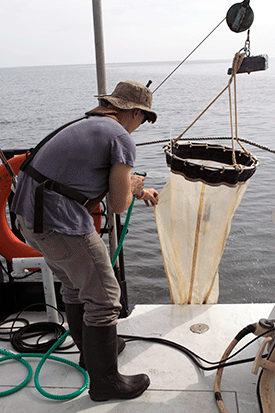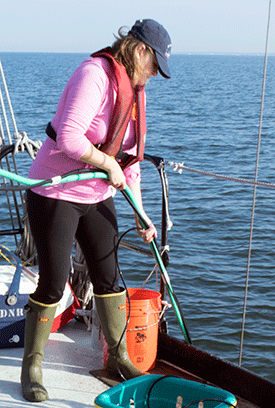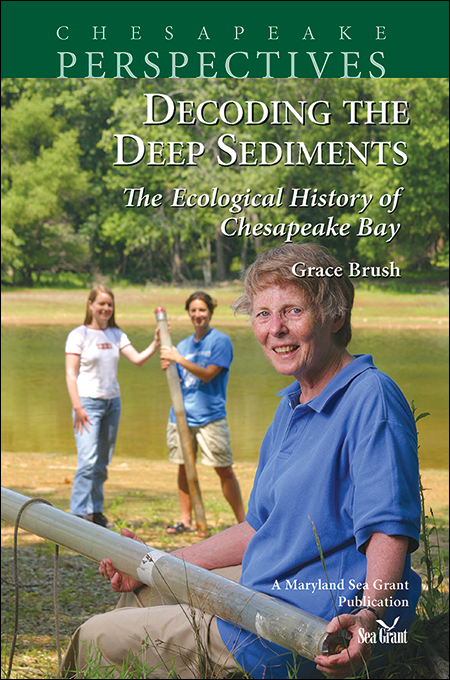Knauss legislative fellowships in Congress help build careers — and they're fun and educational. See our video and fact sheet for details.
Scientists Study Effects of Fall Storms and Wind on Bay’s “Metabolism”
"Shaking Up the Entire Bay Like a Soda Can"
When a big storm has passed over the Chesapeake Bay, you can look around after and see the signs, like floating wooden debris. Storms also affect the Bay’s ecology, and to see these effects, you must look more closely, using the tools of science.
A team of researchers at the University of Maryland Center for Environmental Science (UMCES) took a close look at two big weather systems as they hit our region in October 2015. An unnamed Nor’easter that dumped rain was followed quickly by the remnants of Hurricane Joaquin.
The scientists wanted to study the effects of storm-driven winds and stormwater runoff on the Bay’s water chemistry and biology. Those findings could help improve understanding about the low-oxygen (hypoxic) water that plagues the Bay and stresses fish populations in warmer months. Relatively little is known about how storms affect the Bay’s biological productivity -- its “metabolism,” as Lora Harris of UMCES’ Chesapeake Biological Laboratory (CBL) puts it.
The October squalls presented special opportunities to increase and broaden that knowledge. The storms mostly missed the Susquehanna River watershed, which stretches north from the Bay’s upper end through Pennsylvania into New York. The Susquehanna is the Bay’s single largest source of freshwater, and after previous big storms the river has often dumped large pulses of muddy, nutrient-laden stormwater into the Bay’s northern end. But the October storms dropped rain further south.
This allowed the scientists to study the effects of wind and runoff on the mid-Bay minus the additional effects of a big, nutrient-laden pulse from the Susquehanna. Or as Harris put it, “We wanted to see what happens if you don’t slam the Bay with a lot of nutrients but you shake up the entire Bay like a soda can.”
 |
|
Ryan Woodland, a fisheries scientist, recovers a net pulled up though the Chesapeake Bay’s water column to collect phytoplankton and zooplankton. He and colleagues planned to study whether storms help drive spurts in populations of these tiny marine organisms, on which fish depend for food. Credit: Jeffrey Brainard |
It's important to study storm winds because they help to mix together the Bay’s water layers. Each spring and summer, separate layers form in the Bay’s main stem and often persist into the fall. A warmer blanket of mostly fresh water rests like a blanket atop a colder, saltier layer. Winds tend to mingle these layers, triggering changes in the Bay’s chemistry and biology.
As the October storms approached, Maryland Sea Grant quickly provided funding to a team of UMCES scientists led by Harris to take measurements and collect water samples to study these changes as they were occurring.
As the Nor’easter hit, the scientists motored through turbulent waters and gale force winds aboard a research vessel, the R/V Rachel Carson. And they headed out again a few days later on a series of research cruises when the sun again shone. I joined one of these trips, on the R/V Kerhin, to learn about their study.
The scientists visited the same four monitoring locations, stretched in a line south of the Bay Bridge. To measure the water’s mixing, the scientists collected water samples from a pump and long hose that snaked overboard. They drew water from the bottom of the Bay’s deep channel, about 100 feet down, and close to the surface.
Back in the laboratory, Laura Lapham, another CBL researcher, would analyze the samples to study how the storm affected concentrations of methane. This powerful greenhouse gas is produced by bacteria in the Bay’s bottom sediments during warm months when oxygen levels there drop.
Methane is a powerful greenhouse gas and carbon compound, so Lapham is studying under what conditions it is released from the sediments – and what happens to it next. Fortunately, bacteria consume this methane most of the time. But when oxygen levels in the Bay’s bottom layer drop over summer, the bacteria consume methane at a slower rate, and concentrations of the gas in this bottom layer rise.
By mixing the surface and bottom layers, storm winds free the methane to move up and bubble out of the Bay into the atmosphere. Lapham planned to look for signs in the water samples that the October storms drove up methane concentrations in the Bay’s upper layer.
Ryan Woodland of CBL looked for signs of another possible storm effect – a surge in the Bay's population of plankton. A surge could be fueled by an increase in nutrients churned up by storm winds and carried into the Bay in stormwater.
On the boat, Woodland lowered a fine-mesh net to collect samples of phytoplankton and the zooplankton that feed on them. On deck, he carefully removed a gelatinous clump from the mesh and doled it out into a set of sample containers. Later he and a colleague would dry and weigh the biomass collected and conduct other analyses.
 |
| Ecologist Lora Harris works to collect water samples about the R/V Kerhin. Studying how storms change the Chesapeake Bay's water chemistry and carbon consumption can improve our understanding of the Bay's ecosystem and its water-quality problems, she says. Credit: Jeffrey Brainard |
Harris took water samples back to her laboratory to measure yet another aspect of the Bay’s metabolism — the rate at which bacteria in the water were consuming oxygen. She and her colleagues planned to compare these data with measurements of changes in nitrogen and dissolved organic carbon to examine whether the storms sped up the consumption of carbon in the Bay. The UMCES researchers have yet to finish analyzing these and other data they collected on the research trips.
It’s important to study carbon consumption in the Bay — and how it is affected by storms — because an oversupply of carbon is the “disease” plaguing the estuary, Harris says. “The actual direct cause of dead zones and hypoxia is a lot of carbon being respired [consumed] by bacteria, using up all the water column dissolved oxygen,” she said.
“We need to revisit on occasion what eutrophication actually means,” Harris adds. “It’s not just nitrogen” flowing off the land into the Bay – “that’s just the cause. And low dissolved oxygen is a symptom. Eutrophication is the process of having more carbon in a system.”
Photo, top: Biogeochemist Laura Lapham recovers equipment that she and colleagues lowered in the Chesapeake Bay to collect water samples at different depths. She planned to analyze samples collected in shallow waters to study how storms affect concentrations of methane, a greenhouse gas. Credit: Jeffrey Brainard
See all posts from the On the Bay blog





